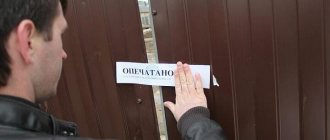Basic moments
According to Article 77 of the Tax Code of the Russian Federation, the seizure of a citizen’s property can be carried out by the tax or customs service if the owner of the property has debts to organizations.
In accordance with the provisions of the Criminal Code of the Russian Federation (Article 115), arrest is imposed on a financially responsible citizen who is a suspect or accused. The very concept of “seizure of property” means that the person whose things have been detained will not be able to dispose of them. In particular, the possibility of making purchase and sale transactions, transferring property as a gift, or including a person in a will will disappear.
In some situations, the seized item is confiscated. Confiscation of an object is carried out by issuing a writ of execution with the involvement of bailiffs. During an arrest, FSSP employees are required to invite witnesses and draw up a report on the confiscated items. After this, the seized items may remain with the owner. If storage of the seized property is refused, the bailiff may transfer the items to another location.
Why remove the arrest from the apartment?
The owner of the seized property is limited in the ability to perform legally significant actions with his property. He cannot have his own living space:
- sell,
- give,
- bequeath
- change.
Relatives cannot be registered in a home that is under arrest or rented out. The owner of the apartment has difficulties, to resolve which it is necessary to remove the imposed restrictions. When you buy a foreclosed home, you can find yourself in an unpleasant situation. Encumbrance can be initiated:
- judicial authorities on the basis of a statement of claim from the injured party;
- bailiffs after receiving a court order or as part of enforcement proceedings;
- state customs employees;
- the prosecutor's office;
- investigative authorities.
A home can be seized if the owner owes a large amount of money to banks, other organizations or individuals. The court has the right to limit the rights of the home owner if he has caused physical, moral, material damage to the organization or citizens. In this case, the apartment serves as security for the claim of the injured party.
Investigative authorities may insist on the seizure of residential real estate when a case of major theft or fraudulent activity is being conducted, especially if representatives of the investigative authorities suspect that the apartment was purchased with stolen money. It is understood that the property can be used to partially compensate for the damage caused. The court has the right to confiscate property from a citizen who has committed an unlawful act.
To restore his rights to property, the home owner must find out who exactly introduced the restrictions and for what reason. Then you will have to pay the debts or challenge in court the legality of the actions of the arresting authorities. Only after this can the burden be removed.
If the buyer has decided to buy a house that is under encumbrance, but does not know how to buy a seized apartment, he should contact a notary. The seller and buyer can enter into a purchase and sale transaction if the debt for the owner of the home is paid by the future owner. Naturally, the paid amount must be deducted from the cost of the apartment.
Removal of arrest from the apartment by the bailiff
I found out that my apartment has been under arrest for seven years. I went to court. bailiffs with an application to lift the arrest, they refused me, guided by Article 14.64.1 of the Federal Law. But the resolution states that all interim measures in the individual entrepreneurs have been canceled, and the seizure of property is listed in Rosreestr. And, how do we understand this, is it possible to lift the arrest, where to go next? Thank you.
How to remove a seizure from an apartment imposed by bailiffs. The entire debt was paid off 3 years ago. The arrest is still ongoing, according to the extract from the Russian registry office. Good afternoon It is necessary to contact the bailiffs with a demand to lift the arrest; if the arrest was imposed by the court, then it is necessary to apply to the court with an application to lift the arrest.
We recommend reading: From what date do the Ministry of Internal Affairs switch to winter uniforms?
Existing types of proceedings
Typically, the process of removing restrictions on property takes place in civil court. But, if a criminal offense has been committed, the location of the case changes. There are a number of significant differences between civil and criminal cases.
| Proceedings under civil law | criminal process |
| The plaintiff may change the original demands or abandon them altogether. | The consideration of the case does not depend on the wishes of the plaintiff. An exception may be when the 2 parties can come to a peaceful agreement. |
| The degree of damage or the likelihood of restoration of the owner's rights is determined. | The level of lawlessness is set. After the death of the sentenced person, the decision of the judicial authority does not apply to relatives. |
| The proceedings are aimed at satisfying the plaintiff's demands. | Focused on the interests of the country and legislation. |
But the main difference between the processes is the inability of the applicant to influence the course of the proceedings if they are carried out within the framework of criminal law.
How to find out if there is an arrest and who imposed it
Only the body by whose order or petition the seizure was imposed can remove restrictions from a residential property. Cancellation of the ban on a citizen’s right to fully dispose of his property occurs at the request of:
- owner;
- a trusted or interested person;
- judicial authorities.
You can obtain information about the existence of a seizure on the apartment and the government agency that imposed the restrictions via the Internet or from the My Documents organization (MFC). Any interested person, knowing the address of the residential premises, can submit a request on the Rosreestr portal. Information about the condition of the housing stock and its owners, according to state law, is not classified as secret or personal, so anyone can receive it. Information about all restrictions relating to citizens' real estate is available in Rosreestr.
The easiest way to get the information you need is via the Internet. You can order an extract from the Unified State Register on the Rosreestr portal. The document is issued for a fee, the cost of the service depends on the completeness of the information reflected in the document. The letter can be received in several ways:
- by mail;
- at the Rosreestr office;
- to the e-mail of the service customer.
You can order an extract through the government services portal or on real estate intermediary websites. To place an order for an information letter, you need to know the exact address of the home or its cadastral number. After submitting a request for a service, you will receive an email with your order number and bank details. Payment can be made in any available way:
- through the bank - online;
- transfer from a card;
- cash via ATM.
Practice on how to correctly remove the arrest from an apartment: procedure, deadlines and sample application
You can obtain information about the existence of a seizure on the apartment and the government agency that imposed the restrictions via the Internet or from the My Documents organization (MFC). Any interested person, knowing the address of the residential premises, can submit a request on the Rosreestr portal. Information about the condition of the housing stock and its owners, according to state law, is not classified as secret or personal, so anyone can receive it. Information about all restrictions relating to citizens' real estate is available in Rosreestr.
The seizure of real estate is understood by lawyers as a restriction imposed on a house or apartment. The owner cannot fully dispose of his property. If he nevertheless decides to sell or bequeath the property, he will have to pay all debts. How to lift the arrest from an apartment, where you need to go in order to fully restore your rights to housing - we’ll look at it in more detail below.
What is subject to arrest
The debt collection procedure begins with an attempt to seize the funds of the offending person. Depending on the situation, different currencies are used. The size of the debt must correspond to the size of the payment. If the debtor does not have enough money, collection takes place through the seizure of property. The person subjected to such punishment has the right to personally indicate the things subject to confiscation. Otherwise, the bailiffs have the right to seize the property themselves. Items subject to seizure are:
- precious things;
- objects of art (paintings, souvenirs);
- cars;
We invite you to familiarize yourself with: Compensation for damage in case of an accident from the culprit, procedure, sample.
There are other valuables that may be subject to seizure.
| Bank card | Subject to arrest first. The money on it goes to the claimant. In the event that there are not enough funds to repay the debt, the demand for collection is transferred to the current account. When the seizure is lifted, the citizen must submit an application to the authority that seized the card. |
| Checking account | The procedure for lifting the arrest is similar to the actions with the card. The person who repaid the debt must write a statement and provide documents. After a satisfactory solution, the bank provides the opportunity to use the account again. |
| Real estate | When lifting and seizing an apartment, you need to take into account all the nuances: is anyone else registered there, are there any minor children living there. In the case where spouses live in the apartment and they have equal rights to the property, only the debtor’s share is seized. The debtor will be able to use the apartment after the arrest is lifted. |
| Automobile | Removing the arrest from a vehicle is possible only through the judicial authorities. It is carried out with the help of a claim and relevant documents. Sometimes it happens that even if there is an executive decision, it is impossible to seize a car. For example, if the debtor left the car as collateral, but it is used by a person who is part of the group of disabled people or war veterans. |
How to remove the arrest from an apartment - restrictions and nuances
A lien is not imposed on real estate in the case where it turns out to be the owner’s only home. The exception is an apartment purchased using mortgage funds. This information is reflected in the conditions signed with the credit institution; by signing it, the borrower agrees to this condition.
The process of seizing property is extremely simple. You can only file a petition for seizure in court. The petition can be submitted together with the statement of claim, or separately without it. According to the norms, such a petition is required to be considered on the day it is submitted.
Procedure for lifting arrest
The restriction on the use of seized items may be complete or partial. Following the adoption of the resolution, the bailiff makes the necessary notes. The sequence of the process is implemented in accordance with current legislation. The release of property from seizure may be accompanied by the following features:
- The citizen fully fulfilled the obligations on the basis of which the enforcement case was initiated. The debt can be repaid after the court has issued a ruling to end the proceedings.
- Fines against the applicant are canceled if a controversial situation arises. For example, disagreements regarding an incorrect ruling on the ownership of seized objects.
- An appeal is allowed to initiate the process. It should be filed in situations where the decision is inaccurate regarding the claim of a material nature. This limitation may be the amount of debt. If it does not exceed 3,000 rubles, arrest is not used as an incentive measure.
Each of the analyzed situations has an established sequence of execution. Applications must be completed in different ways and submitted within different deadlines. The package of documents that will need to be prepared to perform the action also differs.
Once it is clear on whose initiative the apartment was seized, you can begin the procedure for lifting the restrictions. If the apartment was seized for debts to utility services, you need to cover the entire required amount in full. With receipts and other types of payment documents confirming the transfer of money to the plaintiff, the defendant is sent to the service that seized the property.
Through bailiffs
You can determine the reason for the seizure of the apartment at an appointment with an employee of the district department of the FSSP at the place of registration of the home owner. You should also apply here if the restriction of the rights of the apartment owner was introduced at the initiative of employees of this body. The bailiff can limit the rights of the owner by court decision or independently, relying on existing enforcement proceedings.
After paying the debt, the defendant must write a statement asking to restore his rights. In addition to the owner, his authorized representative can lift the seizure of the property.
Along with the application, a package of documents is submitted to the FSSP:
- applicant's passport;
- power of attorney, if the interests of the owner are represented by another person;
- paid checks.
Through the court
What to do if your property is seized?
In Art. 146 of the Code of Civil Procedure of the Russian Federation contains restrictions that indicate a list of property that is not subject to seizure. The right of ownership cannot be limited to:
- real estate that is the only place of residence (exception - the arrest is carried out as part of a mortgage);
- household items (clothing, kitchen utensils, bathroom accessories, etc.);
- items of a professional nature of the debtor (at a certain cost);
- pets and things that help care for them (food, buildings);
- things needed for the harvest (including the seeds and seedlings themselves);
- funds, the amount of which does not exceed the subsistence level;
- household items of the debtor if he is disabled;
- award items (prizes, medals, etc.).
Of course, property is seized in order to force the debtor to fulfill all obligations, that is, to pay the debt. Based on this, we can draw a logical conclusion that in order to lift the seizure, it is necessary to fulfill the obligations due to non-fulfillment of which the property was seized.
Arrests can also be canceled in the event of disputes between the parties. Typically, such disputes arise if ownership rights to the seized property are not correctly established. Law 229 “On Enforcement Proceedings” in Article 118 provides information on ways to resolve such situations. But it is not uncommon for such disputes to be resolved in court.
You can also file an appeal and appeal the court decision, because often the court makes incorrect decisions on claims of a material nature, as an example of a situation where the court seizes property when the amount of debt does not exceed 3,000 rubles, although if the debt is less than the amount, then the arrest cannot be imposed.
In order to lift the seizure of property, it is necessary to prepare all the necessary documents and an application to the court, which indicates the reasons why all restrictions on the property should be lifted.
Please be aware that only the owner of the seized property has the right to file an application to the court to lift the seizure (restrictions), but there are exceptions when the seized property is owned by several individuals or legal entities. You can also hire a representative by preparing a power of attorney for him, and in this case he will be able to file a claim in court under a power of attorney, acting on your behalf.
In your application to lift the lien, you must state the reason why you believe the lien should be lifted from your property. Moreover, you need to substantiate your demands as competently as possible, you must have arguments that are maximally supported by laws, and a clear logical chain must be built.
Therefore, I always recommend seeking at least minimal advice from a competent lawyer. I do not dare to give specific recommendations here, since each case is unique and the practice on such issues is varied and enormous, so this is simply beyond the scope of the article. But still, be sure to consult with a lawyer about your problem; this must be done.
We suggest you read: How to sue a percentage of profits
Before filing a claim, you need to pay a state fee and the amount of payment will directly depend on the value of the seized property.
After filing a claim, the court will set a date for the first court hearing at which the proceedings will be held, the court will decide on the validity of your demands regarding the removal of restrictions (seizure) from your property. During the trial, all circumstances will be clarified, all evidence will be considered, and debate will follow.
If the court makes a decision that does not suit you, then you can always appeal the court decision and I advise you to always appeal the court decisions, since you will still have, although not a great chance, to appeal the court decision and remove the seizure from the property. But to appeal, it is also necessary to prepare copies of all the necessary documents and competently substantiate the reason, as well as point out the obvious errors of the court that, in your opinion, made the wrong decision.
The best reason for lifting the arrest will be an indication of obvious and gross errors made during the arrest, since during the arrest the bailiffs must act strictly according to the law.
If the court makes a positive decision, then a copy of the decision must be sent to the authorities through which the property was seized within 3 days, and this is usually a bank, traffic police or Rosreestr, since both movable and immovable property (car, apartment) are seized. After receiving a copy of the decision, the arrest must be lifted. If it is possible to deliver the decisions yourself, then ask the court for the required number of copies and deliver them yourself, it will be faster, since the court will send the documents by mail, which takes a long time and is not always reliable.
In such a situation, persons whose property was seized, instead of the debtor’s property, may file a claim to exclude the seized property from the inventory.
In addition, the person whose property was described instead of the debtor's property will have to prove in court that the property belongs to him and was described by mistake; for this, the court must provide checks and receipts for the purchase of this property, sales contracts and other documents to prove ownership of the property confirming that the property does not belong to the debtor.
That is, if you want to free property from seizure and exclude it from the inventory, then you must provide maximum evidence that the property belongs to you and not to the debtor.
You can also refer to witness statements. We sue not the bailiffs, but the debtor and the collector, and the bailiffs are brought in as third parties.
After the court considers all the circumstances of the case, considers all the evidence, examines the materials, it will make a decision to release the property from seizure and exclusion from the inventory, or to refuse to satisfy the claim if the court could not be convinced of the ownership of the property.
If the decision was positive, then the court will send a copy of the decision to the FSSP, where the bailiff will remove all restrictions from the seized property.
That’s all for me, I hope the article was useful to you, and if you still have questions, ask our lawyer on the website and he will advise you.
Know your rights. Wish you luck!
About the author:
Larin Alexander. Project manager, currently a practicing specialist with a total legal experience of more than 10 years. Graduated from Moscow State Law Academy (O. E. Kutafin University) in 2006. Professional areas mainly Civil Law, Consumer Rights Protection, Labor Disputes. Author of more than 250 articles on the corporate blog.
Procedure for removing seizure from a property
- Paid the state fee. First of all, it was necessary to pay the state fee. According to the law, only the owners of the property can perform these actions. In addition, it was necessary to submit documentation to the judicial inspectorate indicating that the seized property belonged to the applicant. It was also necessary to prepare all other documents confirming the elimination of the reasons for the arrest. For example, in my case it was checks for payment of mortgage debt;
- Wait until the day of trial . After submitting your application, you will need to wait a certain period of time. As a result, a court date will be set. The applicant will be notified of this. During this procedure, a decision will be made as to whether to remove the seizure from the property. If the judge has arguments to reject the applicant's request, which the latter cannot refute, the arrest will remain;
- Appealed the decision. In my case, the judge rejected the request to annul the arrest, and did so unreasonably. I consulted with a lawyer and found out that, according to current legislation, the restrictions still had to be lifted. In this regard, I had to appeal this decision by reporting to higher authorities. I also did this by filing a counterclaim.
We recommend reading: Benefits for disabled people in St. Petersburg
If a housing property that belongs to a certain individual is seized, the owner is automatically deprived of the right to dispose of it. However, the owner is still allowed to live in it. It is prohibited to sell this property, exchange it, provide it for rent, and so on. If the owner of the seized property violates the current rules, then criminal liability will be imposed on him. Some citizens mistakenly believe that an arrest can be hidden. However, this is not the case, because the relevant information is entered into the state register.
Individual situations
In recent years, the state has tightened laws aimed at punishing alimony providers and ensuring the possibility of collecting money from them to minor children and elderly relatives. A bailiff has the right to seize the only home of a person who owes money to his young children. A FSSP employee has the right to impose an encumbrance if there is an alimony debt of 3,000 rubles or more.
The burden on the home of an unscrupulous parent can be removed in two ways. The first option involves full repayment of the debt. The difficulty in solving the problem lies in the fact that when a large amount of unpaid alimony has accumulated, the debtor is simply not able to pay everything at once. Debt repayment occurs in parallel with the monthly payment of current alimony.
Thus, debt repayment can occur over several years. During this entire period, the negligent parent cannot sell or donate his home to other persons. In the event of malicious evasion or his death, the amount of debt will be recovered through the sale of his property.
The second option allows you to lift the arrest from the debtor’s apartment if the interested party withdraws the writ of execution from the FSSP. However, the situation with the arrest may repeat itself if, after a while, the representative of the alimony recipient again contacts the FSSP employees with a request to recalculate the debt.
After paying off the alimony debt, the citizen must contact the district office of the FSSP where his case is located. A government official will be able to lift the arrest from the apartment only after receiving receipts confirming the transfer of money to the recipient of alimony.
A citizen who has fully repaid his debts to the creditor must obtain a certificate from a specialist in the bank’s credit department stating that this organization has no financial claims against him. He needs this document to lift the arrest and protect himself in the event that after some time the credit institution again begins to demand money from the former client.
We suggest you read: Can an account be seized without bailiffs?
Then, having bills and a certificate in hand, the citizen must go to the specialists of the bailiff service to remove the encumbrance. The official, after receiving all the necessary evidence of the execution of the claim, removes the arrest from the apartment.
How to lift a seizure from your only home
Hello, the bailiffs are not concerned with the debt, but with you, and the restrictions imposed are more than legitimate. No one is depriving you of your housing, but actions with it are limited until the debt is repaid. If you have financial difficulties, then you have the right to go to court so that, for a good reason, you will be granted an installment plan or a deferment of the execution of the court decision.
We recommend reading: Residence permit through the purchase of real estate
Hello, I have a debt to the bank of 1 million, it is handled by bailiffs. They seized the registration actions of the only apartment, the owners are me and my father. Is this legal? I am officially not working, I am now 7 months pregnant with my second child. My daughter, parents, brother, wife and child are registered in the apartment. We want to sell the apartment, since it’s simply not possible for everyone to live together. Recently they called from the bank and said that the bailiffs returned the case to them due to the impossibility of execution. How can I lift the arrest and sell my apartment?
Features of filing a claim in court
To lift the seizure of property, it is necessary to write a statement of claim and submit it to the executive authorities. The document must be completed carefully. The statement of claim specifies the property to be returned.
The completed document must be submitted for review. They will agree to accept a statement of claim to lift the seizure of property if the document is sent to the court personally by the debtor who closed the obligations. A citizen to whom things belong under the rights of economic management has a similar right. The legislation of the Russian Federation does not contain information on the strict form of the statement of claim. However, it is required that it include the following items:
- the name of the judicial authority (district court) where the claim is filed (when the case involves conflict situations, it is possible to transfer the claim to the appellate judicial body);
- information about the parties to the proceedings;
- the amount of the claim filed;
- when opening proceedings to obtain compensation for damage caused by arrest, this fact must be indicated in the application;
- information from the act on the application of punishment;
- list of non-compliance with the law in the process (if any);
- wishes of the applicant (to cancel restrictions or modify the status of property).
After registering the document with the secretary, you need to take a copy of the claim, which is stamped. If a person finds it difficult to draw up an application on his own, the rules allow the use of a ready-made sample. You can find a ready-made document on the Internet.
Any process related to litigation is not complete without paying a state fee. Its amount depends on the value of the property.
How to return the selected rights?
Removal of seizure of property in court is carried out in accordance with Article 144 of the Code of Civil Procedure of the Russian Federation. The process requires preparing certificates, writing and submitting an application. The claim must reflect the grounds for annulment of the arrest. The main aspects of such an act are as follows:
- An application to lift the seizure of property should be submitted to the owner of the seized items. An exception is when property has been seized, the right of ownership of which belongs to several individuals or legal entities. A claim can be filed by a third party. However, it will be necessary to issue a power of attorney for him. It must be previously certified by a notary. Otherwise, it will not be possible to resort to the help of a third party.
- The claim states the grounds for lifting the seizure of the plaintiff's real estate. They must be specified in full and logically argued. It is better if a competent lawyer takes care of the application. This may have a beneficial effect on the court's ruling.
- The citizen is obliged to pay the state fee. Its size depends on the price of the detained property.
- Preliminary hearings are being held regarding the filed claim. They examine the validity of the grounds for lifting restrictions. The court makes the final verdict.
The periods differ in the duration of execution and the features that may be encountered in the process.
How to lift a seizure from an apartment after a court decision
If you want to find out whether this apartment is under arrest, an extract from the Unified State Register will help you. The document indicates the initiator of the seizure and the date of approval of the corresponding measure. To obtain an extract, you will need to pay a state fee, the cost of which is 1200 rubles for legal entities. individuals and 400 rubles for individuals. persons (a document in electronic form will cost 150-300 rubles). To obtain an extract from the Unified State Register, you should contact the MFC or the Federal Reserve System. An extract can also be ordered via the Internet on the Registry website. The owner can clarify whether proceedings have been initiated by visiting the FSSP website or by submitting a passport to the bailiffs.
We recommend reading: Conditions for registering under the young family program in Stavropol
The owner must also remember the possibility of appealing a court decision to a higher authority in accordance with Article 145 of the Civil Code of the Russian Federation. However, the defendant here must have compelling arguments that can convince the higher court to overturn the decision made by the trial court.
Stages of the procedure
Removal of seizure from property takes place in several stages. After filing a claim, you need to collect documents. The plaintiff may be required to provide additional papers and various documented information. The classic procedure in the year is as follows:
- Before the trial, notices are sent by mail to the parties involved in the case. At the hearing, the object of the conflict is considered. Witness testimony is taken into account. During this period, you can send a petition to lift the seizure of property or change judges.
- The court is given a set time frame to analyze the circumstances of the case. A 2nd meeting is scheduled to announce the results. All parties to the trial are required to attend, or the judicial authorities will postpone the hearing. The hearing may be postponed if it is necessary for third parties to participate in the procedure.
- After the judge makes a ruling, you can file an appeal. But such an action can be performed in the presence of circumstances provided for by the legislation of the Russian Federation.
There are cases when restrictions are lifted without trial. Such an action can be carried out if the presence of violations and miscalculations in the arrest procedure is detected. If the court gives an approving ruling on the plaintiff’s claim, a copy of the document must be sent to the institution for the registration procedure within 3 days.
The plaintiff who filed the application is also sent a copy of the decision. Then the following activities are carried out:
- sending the resolution to the FSSP;
- updating information in registers;
- issuance of a fresh document on the restoration of property rights.
Actions to implement a court order can also be carried out by a person chosen as a guarantor. To do this, he must provide a power of attorney certified by a notary. If the plaintiff does not participate in the process, it will drag on for a relatively long period. This follows from the fact that the necessary documentation takes a long time to be transferred from one government agency to another.
How to remove a seizure from an apartment imposed by a bailiff
When ordering an extract, the applicant presents only his passport and indicates the exact address of the object, starting with the region. A state fee of 300-800 rubles is paid for providing data. At the same time, data in the Rosreestr database may also arrive with a delay of several working days, so there is a real risk that recently imposed arrests will not be reflected in the document.
The advantage of this method is that the necessary information can be obtained for free and without leaving home in a few seconds. However, it is important to understand that data may arrive on the Rosreestr website with a significant delay. For example, if an apartment was seized approximately 5-7 days ago, the information may not be displayed. Therefore, in such cases, it is better to use more reliable methods described below.
How long does the procedure take?
The time frame for lifting the seizure of property depends on individual circumstances. It is worth considering that the process can take a lot of time. The best solution would be to hire a legal specialist. Then you can increase the likelihood of a favorable outcome of the trial.
Removing the seizure of property in a year is a complex procedure that requires specific knowledge. To make it easier, you can hire a lawyer. The procedure for releasing property from seizure can take a long time. During this period, it is not permitted to dispose of movable or real estate at your own discretion. You need to know how to correctly fill out an application to remove the seizure of property.
In order for the procedure to begin, the state duty for removing the seizure from the property must be paid. If each step is carried out correctly, you can hope that the process will go as quickly as possible.
How to remove a lien from an apartment
First, we note that only the body that applied for its imposition can remove the arrest from the apartment. At the same time, any interested party can start this process. The easiest way to remove the encumbrance is to pay the debt that caused the restriction. However, it is necessary to repay the debt in full, be it taxes, fees, fines, overdue loan payments, etc., or fulfill other conditions of the court order. The reason for the seizure can be found in the claim on the basis of which the apartment was seized.
The next step will be for the homeowner to file an application with the court. Documents confirming the fulfillment of debt obligations are attached to the application. The court considers and makes a decision. In any case, the interested party can appeal it.
And the final stage is the registration of an application to lift the arrest. They contact the Rosreestr authority, attaching the court decision. This procedure is free. After its successful completion, the property becomes officially vacant.







